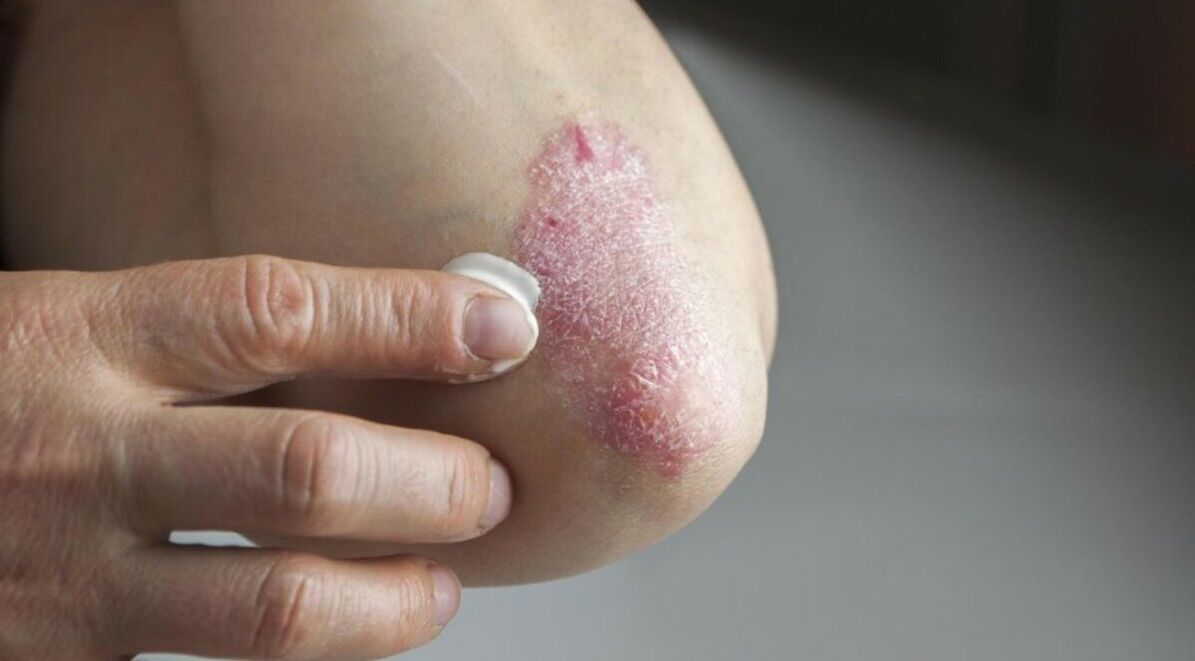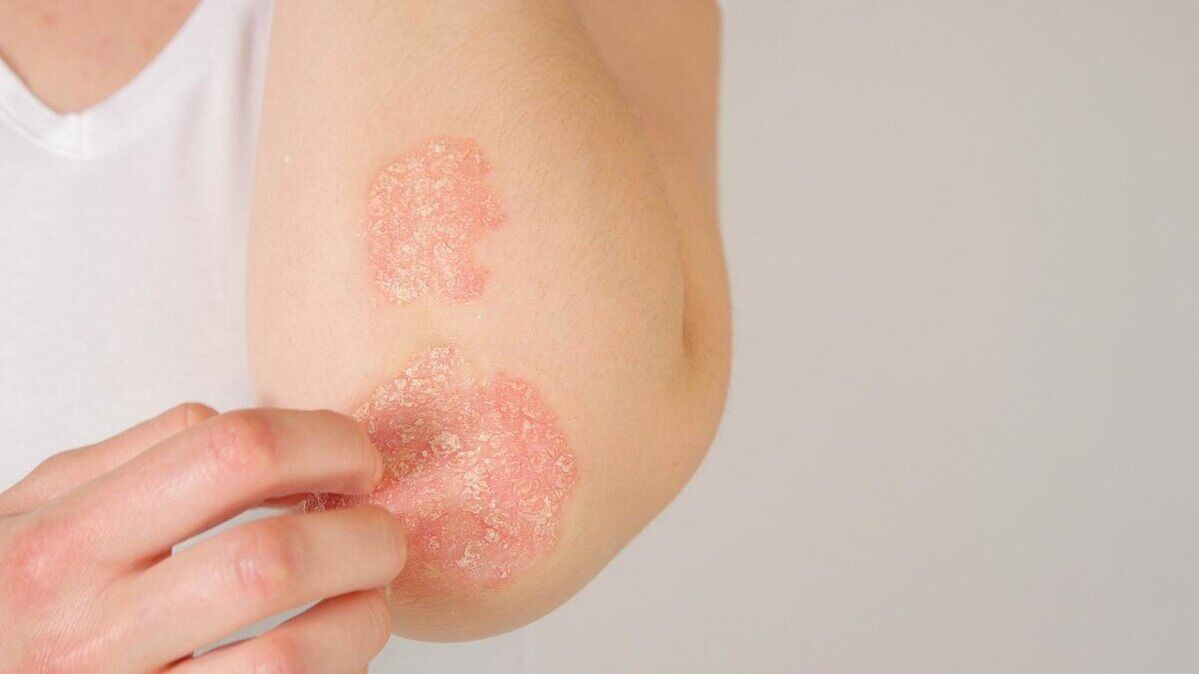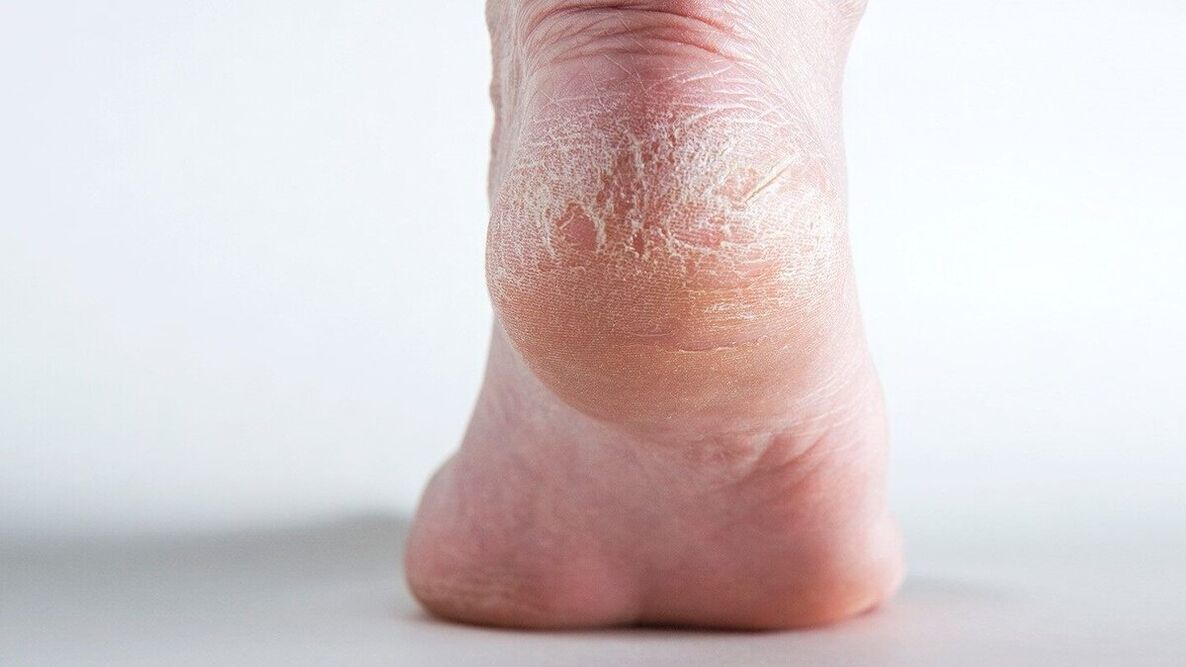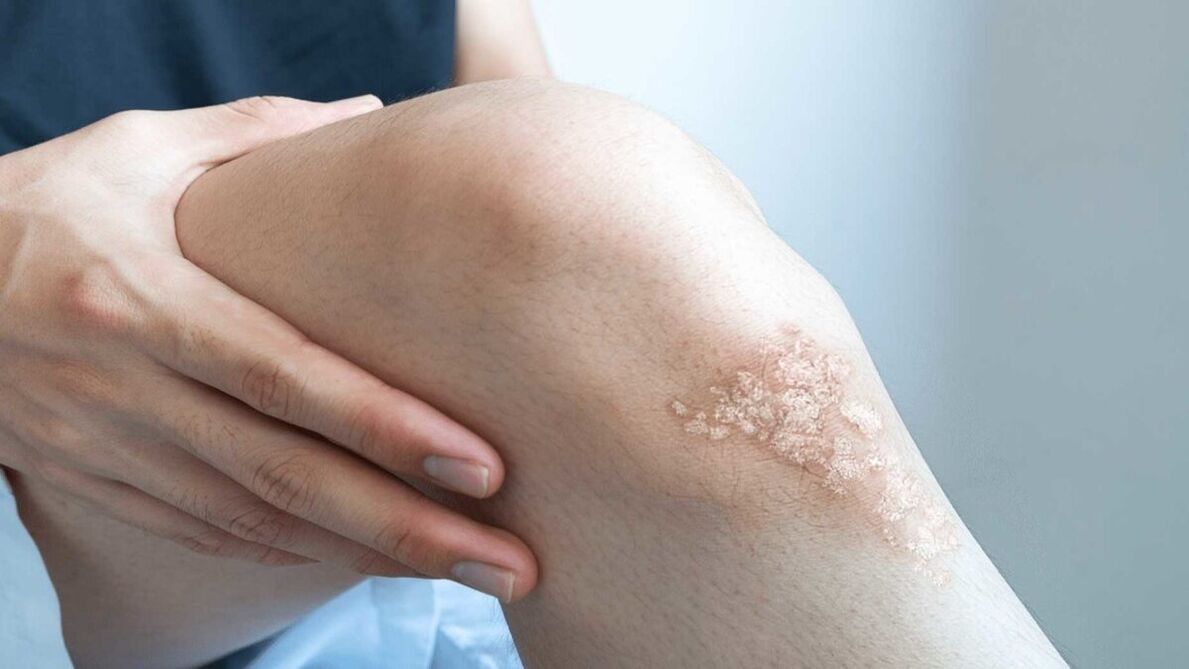
Psoriasis is a dermatological disease characterized by the appearance of red patches with silvery scales on the skin.
Depending on the type, psoriasis affects the knees, elbows, torso, nails, face or scalp.
What is psoriasis?
Psoriasis is an autoimmune disease that causes skin cells to grow too quickly, build up and form inflamed red patches. Symptoms of psoriasis can vary depending on its type, stage and cause. General signs of psoriasis:
- inflamed areas of skin;
- whitish-silver scales or plaques over red spots;
- pain and burning of the skin;
- dry, cracked skin (may itch and bleed);
- stiff, swollen joints;
- thickened and ribbed nails.
Psoriasis in children usually affects the scalp and nails first, then spreads to the elbows, knees, and torso. With nail psoriasis in a child, depending on the type of psoriasis, thick nails without pitting or with small ridges can be observed, as well as yellowing of the nails or their separation from the bed.
If you notice the first signs of psoriasis, you should consult a doctor. A dermatologist deals with the diagnosis and treatment of psoriasis in adults. If red spots on the skin or silvery scales appear in children, you should consult a pediatrician.
How does psoriasis start?
Psoriasis begins with the formation of small red bumps that rise a few millimeters above the skin (outwardly resembling a regular rash). As they grow, white or silver scales may appear. The scales on top may fall off. The remaining scales stick together and begin to hurt and itch. Scratching the resulting rash can cause the scales to break away from the skin, causing bleeding.
What does psoriasis look like?
With psoriasis, red spots appear on light skin and brown or purple spots on dark skin. In the initial stage of scalp psoriasis, the spots look like dandruff (due to white scales). Forms of psoriasis:
- mild form of psoriasis (less than three percent of the body is affected, rashes are localized on the scalp or extremities);
- moderate form of psoriasis (the rash covers three to ten percent of the body, affecting the scalp, arms, legs and torso);
- severe form of psoriasis (more than ten percent of the body is affected, rashes appear on the palms, soles and face).
Treatment for psoriasis is chosen by a dermatologist based on the form and type of psoriasis, symptoms and location of the rash. If treatment is incorrect or untimely, large areas of lesions appear on the skin.
Where can psoriasis occur?
The location of psoriasis spots depends on its type. Types of psoriasis:
- plaque psoriasis (vulgar). Plaque psoriasis causes dry, raised patches of skin covered in silvery scales. Psoriasis appears on the elbows, knees, lower back and scalp;
- erythrodermic psoriasis. The skin feels burned, chills appear and the temperature rises;
- guttate psoriasis. Small flesh-colored, scaly spots, similar to drops of water, form on the arms, legs and torso;
- pustular psoriasis. With pustular psoriasis, white blisters filled with pus and large inflamed areas of skin form on the skin. Localized in small areas of the skin, affecting the legs or arms;
- exudative psoriasis. Spots covered with yellow crusts appear on the skin;
- reverse psoriasis. Smooth red spots appear on the skin. The rash appears in the folds of the skin (armpits, buttocks, genitals).
In nail psoriasis, skin builds up under the nails, causing them to lift and form indentations ("nail pits"). The skin under the nail plate turns white, yellow or brown. Nails become rough, crumble and break quickly.
Dermatologists also distinguish palmoplantar psoriasis. The skin affected by psoriasis on the palms and feet is dry and prone to cracking.
Eyelid psoriasis causes redness, flaking, and crusting around the eyelids. Other symptoms of psoriasis on the eyelids:
- the formation of scales that peel off and stick to the eyelashes;
- pain when moving the eyes;
- irritation of the skin of the eyelids, accompanied by pain and itching.
The edges of the eyelids may raise or lower depending on the location of the spots, leading to friction between the eyelashes and the eyeball. Possible consequences of eyelid psoriasis include uveitis (eye inflammation) and vision loss.
Psoriasis can appear on the eyebrows, behind and around the ears and in the ear canal. Sometimes psoriasis affects the mouth, causing redness and burning on the lips, gums, tongue and cheeks. Oral psoriasis can cause difficulty chewing and swallowing food.
The manifestations of psoriasis depend on its type, symptoms and stage. Psoriasis is visible in the photo.



Reasons for the development of psoriasis
Psoriasis is caused by a malfunction of the immune system, in which white blood cells mistakenly begin to attack skin cells. Thanks to the action of leukocytes, the process of producing new skin cells is reduced from one month to several days. Prematurely formed cells are pushed by the body to the surface of the skin, where they accumulate and turn into spots or plaques.
Genetic predisposition (family history of psoriasis) or triggers (environmental factors that increase the risk of psoriasis) can lead to immune system dysfunction. Factors that provoke the development of psoriasis:
- infections (tonsillitis, herpes, lichen);
- skin trauma (sunburn, insect bite, scratches, cuts);
- smoking or abusing alcohol;
- uncontrolled use of medications;
- regular stressful situations (leading to the development of stress psoriasis);
- weather conditions (dry and cold conditions);
- abrupt discontinuation of systemic or oral corticosteroids.
These factors can lead to the development of psoriasis in people who are predisposed to it, or cause an exacerbation. Exacerbation of psoriasis can be avoided by identifying and eliminating contributing factors.
Exacerbation of psoriasis
Psoriasis of the face, extremities and head is characterized by periods of exacerbation (symptoms appear intensely) and remission (the rash decreases in size, the pain disappears). Remission periods last from a month to a year. Stages of psoriasis:
- progressive stage(onset of psoriasis). Small nodular rashes appear on the skin, accompanied by itching. Areas of redness increase, forming plaques;
- stationary scene. New nodules (papules) do not appear, the inflammation disappears after the formation of scales or crusts on the plaques;
- regressive stage. The plaques diminish, the itching and flaking disappear.
A dermatologist will help relieve an exacerbation of psoriasis, who will identify the triggers and prescribe treatment. Following your doctor's recommendations will help reduce periods of exacerbations and increase periods of remission.
How to treat psoriasis?
Before starting treatment for psoriasis, the dermatologist takes a history (asks about symptoms, when they appeared, and whether there is a family history of psoriasis) and performs a visual examination of the rash. After making a diagnosis, the doctor selects a comprehensive treatment for psoriasis. Treatment for psoriasis includes:
- ointments, shampoos, creams and gels based on extracts of algae and minerals from the Dead Sea;
- phototherapy (by exposing the skin affected by a rash to ultraviolet rays, the growth of skin cells is reduced, leading to normalization of the condition).
For psoriasis, a dermatologist recommends taking vitamins. To produce healthy skin cells and reduce inflammation and symptoms, your doctor will prescribe vitamins A, D, E, K, B, and C.
Diet for psoriasis
For psoriasis, a dermatologist recommends dietary changes. Foods that reduce inflammation:
- fatty fish (tuna, salmon);
- flax and pumpkin seeds;
- nuts (walnuts, almonds);
- cabbage, spinach.
Following a psoriasis diet helps reduce symptoms and prevent the development of complications (high blood pressure, diabetes, heart disease). If you have psoriasis on your legs, arms or face, you should limit your alcohol consumption.
Your diet should also include the consumption of foods containing fatty acids (sardines, salmon, shrimp, flax seeds). It is recommended to minimize the consumption of foods containing saturated fats (fatty meats, confectionery) and simple carbohydrates (dairy products, grapes, pastries).
Psoriasis prevention
Preventive measures will help prevent the development and progression of psoriasis on the arms, legs and head. Psoriasis prevention includes:
- dietary changes (abstinence from alcohol, simple carbohydrates and saturated fats, consumption of foods containing fatty acids);
- protect your head and body from the sun (with sunscreen and a hat);
- stop smoking;
- reduce the risk of skin lesions (use of anti-insect sprays, gloves, long sleeves);
- moisturize the skin (dry skin is prone to damage).
To reduce the risk of psoriasis flare-ups, extreme temperatures should be avoided. Exposure to temperatures that are too cold or too hot can dry out or damage your skin. Minimizing stressful situations will help prevent the onset of psoriasis due to nervousness.
How to distinguish psoriasis from dermatitis?
Scalp psoriasis (seborrheic psoriasis) is similar to seborrheic dermatitis. Dermatitis can be distinguished from scalp psoriasis with the help of a dermatologist. Symptoms of seborrheic dermatitis:
- redness of the skin, on which white or yellow greasy scales form (when pressed, sebum - sebum - can be released);
- dandruff (skin flakes) that builds up near the hair shaft.
You can distinguish psoriasis from dermatitis by the location of the rash. Unlike seborrheic dermatitis, psoriasis forms not only on the head, but also extends beyond the hairline and appears on other parts of the body (limbs, lower back, nails). With psoriasis, the areas of skin affected by the rash are painful and itchy, and with dermatitis, you may experience a mild itchy scalp.
frequently asked Questions
- Is psoriasis transmissible?
Psoriasis is not contagious. Contact (communication, kissing, sexual intercourse) with a person with psoriasis, touching the affected areas of the skin will not lead to the appearance of a rash, since it is a self-illness. immune and non-infectious.
- How to wash your hair with psoriasis?
For psoriasis, you can wash your hair with a shampoo made from Dead Sea minerals and algae extract. Independent selection of shampoos and the use of folk remedies (tincture of chamomile, celandine, aloe vera, apple cider vinegar) will be ineffective and can lead to worsening of symptoms. If a rash is detected, you should contact a dermatologist who, after examining the redness and making a diagnosis, will select the treatment option suitable for you.
- How to distinguish nail psoriasis from fungus?
You can distinguish nail psoriasis from fungus using the symptoms. With psoriasis, nails thicken, crumble, break quickly and the skin underneath turns yellow, white or brown. Nails may develop indentations (chips), ridges, or holes.
The fungus causes gray, brown, or green spots on the nails that darken and enlarge over several weeks. Fungal nail infection does not cause pitting, but can cause nails to become thin or thick.
- What should you not eat if you have psoriasis?
If you have psoriasis, you should not eat foods that increase inflammation (dairy products, red meat, fatty foods, refined sugar, citrus fruits, tomatoes, potatoes). You should avoid eating eggs, liver, soy and energy drinks. These products contain choline and taurine, which can cause psoriasis to worsen.
- What can psoriasis be confused with?
Psoriasis can be confused with eczema, ringworm, lichen planus, or lichen planus. A dermatologist will help you distinguish psoriasis from other skin conditions by taking a medical history, visual examination, and performing diagnostic tests.























